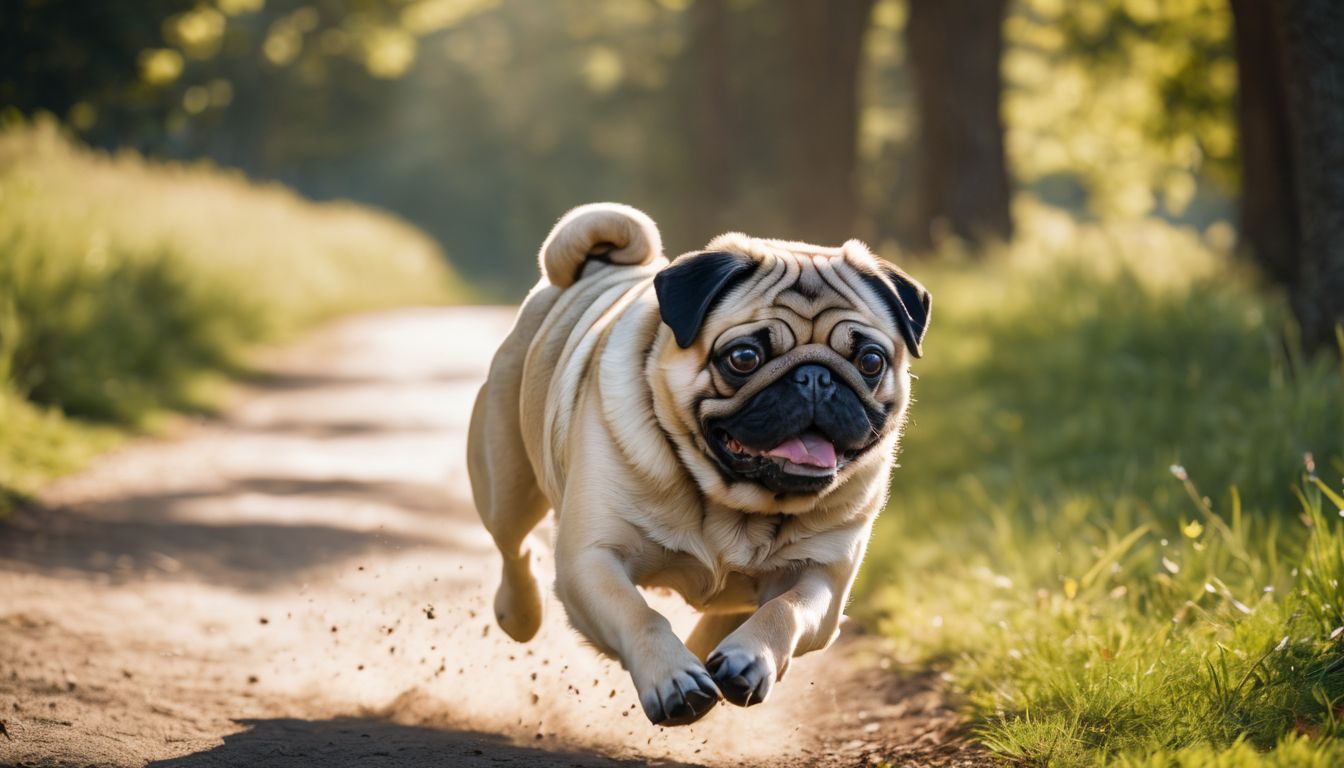Are All Pugs Fat? The Truth About Pug Weight And Obesity
Are All Pugs Fat?
Many pug owners know all too well the struggle of balancing their fur baby’s love for snacks with the need for a healthy waistline. It’s almost like they have a sixth sense for when it’s mealtime, isn’t it? We understand that dance between indulging those big, pleading eyes and keeping your pup in top-notch shape.
So we’re diving nose-first into the world of pug health to bring you tried-and-true tactics for managing your little buddy’s weight. Join us on this journey as we lay out some down-to-earth advice to help your pug lead a joyful life—full of energy but not excess pounds.
Together, let’s bust the myth that pudginess is a pug’s fate!
Key Takeaways
- Not all pugs are destined to be overweight; with proper diet and exercise, they can maintain a healthy weight.
- Obesity in pugs can lead to serious health issues like joint problems, respiratory difficulties, and shorter lifespans.
- Pugs typically reach their full adult size by 9 to 12 months of age, which is the best time to establish a routine for maintaining their ideal body weight.
- A balanced diet for pugs should include high-quality protein, essential fats, fiber-rich veggies, and complex carbs while avoiding overfeeding.
- Consistent physical activity tailored to a Pug’s needs is essential for preventing obesity and keeping them both physically and mentally stimulated.
What is the Ideal Shape for a Pug

Pugs should have a sturdy and compact body with a well-proportioned build. Their weight should be within the recommended range for their size, as obesity can lead to various health issues.
Understanding the ideal shape for a pug is crucial in maintaining their overall well-being.
Pugs and Weight
Pugs charm us with their playful antics and loving eyes, but keeping them healthy means watching their weight carefully. This dog breed tends to gain weight easily, which can lead to serious health problems.
We always aim to maintain our pug’s body condition at a score of 4-5 out of 9 because it helps prevent obesity-related issues such as joint problems and respiratory difficulties.
Managing their diet is key; we have to be mindful about the food portions and stick to high-quality meals that provide all the necessary nutrients without excess calories. Regular walks and play sessions are also essential for our pugs’ well-being.
They might not need intense exercise due to their size, but they certainly benefit from consistent activity that supports weight control and overall health.
Factors that Contribute to Pug Weight
Maintaining a healthy weight in our beloved pugs is crucial for their overall health. Understanding the factors that lead to weight changes can help us keep our four-legged friends in top shape.
- Genetics: Just like people, pugs come with different body types and metabolisms. Some are naturally more inclined to gain weight than others, which is why we should tailor their diet and exercise to their individual needs.
- Diet: The quality and quantity of food we provide play a significant role in our pug’s weight. Feeding them high-calorie foods or overfeeding can easily result in extra pounds.
- Exercise: These little dogs need regular physical activity to burn off energy and stay slim. Without enough exercise, they’re likely to become overweight.
- Age: As pugs grow older, they tend to be less active and have slower metabolisms. Keeping an eye on their changing needs is important as they age.
- Health Conditions: Certain medical issues, such as hypothyroidism, can lead to unexpected weight gain in pugs. Regular check-ups with the veterinary are essential for early detection and management.
- Over-Treating: We all love giving treats to our dogs, but too many can cause weight gain. It’s vital to factor treats into their daily calorie intake and opt for healthier options when possible.
- Spaying/Neutering: Altered metabolism post-surgery often leads to weight gain in dogs; therefore, adjusting their diet post-surgery is necessary.
Understanding Pug Growth

Pugs go through different growth stages, and it’s essential to understand their ideal weight at each stage. By knowing the normal weight for a 6-month-old Pug or understanding the age at which a Pug is fully grown, you can better monitor their development and ensure they maintain a healthy weight.
Growth and Weight Chart
As we navigate through the journey of raising a healthy pug, keeping an eye on their growth and weight is crucial. We’ve crafted a straightforward growth and weight chart that aligns with the proper development stages of our beloved pugs. This tool will help us monitor their progress and ensure they remain within a healthy weight range.
| Age (Months) | Estimated Weight (lbs) | Notes |
|---|---|---|
| 1-2 | 2-4 | Puppy is growing rapidly |
| 3-4 | 4-7 | Weight increases, monitoring diet is key |
| 5-6 | 7-12 | Approaching adult size, adjust food intake accordingly |
| 6-12 | 12-18 | Slower growth, aim for ideal body condition score |
| 12+ | Adult weight | Maintain healthy diet and regular exercise |
Our chart serves as a guide for determining if a pug is on track with its growth. Remember, maintaining a body condition score of 4-5 out of 9 is ideal. Observing their weight progression closely will prevent potential obesity, which might lead to serious health concerns.
It is essential we provide consistent exercise and a balanced diet, tailored to each stage of their growth.
Age of Full-Grown Pug
Pugs typically reach their full-grown size around 9 to 12 months of age. At this point, they have reached their adult height and weight, allowing for a clearer understanding of their ideal body condition.
It’s important to monitor your Pug’s growth during this time to ensure they are developing at a healthy rate and maintaining an optimal weight. By staying attentive to their growth progression and providing appropriate care, you can help them avoid unnecessary health risks associated with obesity.
Understanding the age at which a Pug reaches full maturity enables us to make informed decisions about their diet, exercise routine, and overall well-being as we strive to maintain their health throughout every stage of life.
Once our Pugs reach adulthood, it’s crucial to continue monitoring their weight closely while also ensuring that they receive proper nutrition and regular physical activity.
Normal Weight for a 6-month-old Pug
Now that we know when Pugs reach their full size, it’s essential to understand the normal weight for a 6-month-old Pug. At this age, a male Pug should weigh between 10-12 pounds (4.5-5.4 kg), while a female Pug’s ideal weight would be slightly less, ranging from 8-10 pounds (3.6-4.5 kg).
It is crucial to keep an eye on your puppy’s weight and body condition during this time of rapid growth to ensure they stay healthy and maintain a proper body condition score.
By the age of six months, a well-nourished and properly cared for Pug puppy should display an alert and energetic demeanor with good muscle tone – clear signs of being at an ideal weight for its age.
Risks of Obesity for Pugs
Obesity poses significant risks for pugs, especially due to their brachycephalic nature, which can lead to breathing difficulties. Excess weight around the neck, chest, and face puts pressure on the respiratory system, making it harder for pugs to breathe.
This can be particularly concerning in hot temperatures or during physical exertion when overweight pugs may struggle even more. Additionally, obesity increases the risk of joint issues and decreases the lifespan of these beloved pets.
Furthermore, overweight pugs are prone to developing various health problems such as respiratory issues and shorter lifespans. It’s important to monitor a pug’s weight closely and take necessary steps if they are deemed overweight.
The excess fat accumulation not only affects their physical health but also impacts their overall well-being; therefore, managing a healthy weight is paramount for a vibrant life for these affectionate companions.
As we delve deeper into understanding the challenges faced by overweight pugs, we must highlight actionable strategies that can help prevent them from becoming obese.
Tips to Help A Pug Lose Weight
Provide your pug with a healthy diet, occasional treats in moderation, plan their meals, and ensure they get sufficient exercise to help them shed excess weight and maintain a healthy lifestyle.
Want to learn more about how you can help your pug reach their ideal weight? Keep reading for valuable insights and practical advice.
Healthy Diet
Pugs require a balanced and nutritious diet to maintain a healthy weight. A diet consisting of high-quality protein, essential fats, fiber-rich vegetables, and complex carbohydrates is crucial.
Avoid overfeeding and monitor portion sizes to prevent weight gain. Additionally, consult with a veterinarian for specific dietary recommendations based on your pug’s age, size, and activity level.
A well-planned meal schedule can help regulate your pug’s food intake. Providing consistent mealtimes and avoiding excessive treats can contribute to maintaining an optimal body condition score for your pet.
Occasional Treats
Pugs enjoy occasional treats, but it’s crucial to monitor their quantity and quality. Excessive treats can lead to weight gain and health issues. Opt for healthy options such as carrots or apple slices instead of high-calorie snacks.
Remember that moderation is key when giving treats to your Pug. Monitoring treat intake can help maintain a healthy weight and prevent obesity-related problems.
Balanced diets are essential, so only choose high-quality treats that complement your Pug’s main meals. Consider incorporating treats into your Pug’s daily calorie allowance to ensure they don’t exceed their recommended intake.
Meal Planning
When planning meals for your Pug, it’s essential to consider their specific nutritional needs. We should focus on providing a balanced diet that includes high-quality protein, healthy fats, and essential vitamins and minerals.
By measuring their food portions according to their ideal weight and activity level, we can help control calorie intake and prevent overfeeding. Additionally, regularly adjusting the meal plan as they age or if there are changes in their exercise routine is crucial in maintaining an optimal weight for our furry companions.
Exercise
It is essential for Pugs to engage in regular exercise to maintain a healthy weight and overall well-being. Daily walks or playtime can help prevent weight gain and obesity, while also enhancing cardiovascular health and muscle tone.
The key is to provide moderate but consistent physical activity, tailored to your Pug’s age and fitness level. Additionally, interactive games such as fetch or agility exercises can be enjoyable ways for your furry friend to stay active indoors or outdoors.
To support optimal Pug health, consider incorporating low-impact exercises like swimming, which are gentle on their joints yet effective in burning calories. Pursuing various forms of physical activity will not only assist in managing weight but also contribute to mental stimulation and emotional fulfillment for your beloved Pug.
What to Feed a Pug Puppy for Optimal Health
When considering what to feed a Pug puppy for optimal health, it is crucial to prioritize high-quality, balanced nutrition. A well-rounded diet should consist of lean proteins, healthy fats, and complex carbohydrates to support the puppy’s growth and development.
Selecting premium commercial dog food specifically formulated for puppies can provide essential nutrients such as protein for muscle development, omega-3 fatty acids for brain health, and vitamins and minerals for overall well-being.
Additionally, incorporating small amounts of fresh fruits and vegetables into the Pug puppy’s diet can offer additional vitamins and fiber. It is important to avoid feeding them foods that are toxic to dogs such as chocolate or grapes.
In addition to proper nutrition from commercial dog food or home-cooked meals approved by a veterinarian, adequate hydration is essential in maintaining a Pug puppy’s optimal health.
Fresh water should be readily available at all times. Balanced meals coupled with plenty of water will contribute significantly not only to the physical development but also the overall well-being of your beloved Pug puppy.
How to Prevent Pugs from Getting Fat
To prevent Pugs from getting fat, we must pay attention to their diet and exercise routine.
- Provide a balanced diet: Offer high-quality dog food formulated for small breeds like Pugs, with controlled portion sizes to avoid overfeeding.
- Limit treats: Use treats sparingly to avoid excessive calorie intake, opting for healthy alternatives like carrots or green beans.
- Regular exercise: Engage in daily walks and playtime to keep your Pug active and maintain a healthy weight.
- Monitor weight: Regularly weigh your Pug and adjust their diet or exercise as needed to prevent weight gain.
- Avoid free-feeding: Establish a feeding schedule rather than leaving food out all day to control portions and prevent overeating.
- Opt for low-calorie snacks: When giving treats, choose low-calorie options to prevent excessive calorie intake throughout the day.
- Seek veterinary guidance: Consult with a veterinarian for personalized advice on maintaining your Pug’s ideal weight and health.
Maintaining a Healthy Weight for Pugs
Pugs need an appropriate balance of food and exercise to maintain a healthy weight. Regular monitoring of their body condition score is vital for ensuring they do not become overweight or obese.
Providing a balanced diet, limiting treats, and engaging in regular physical activity help in maintaining your pug at an ideal weight. It’s essential to be mindful of the potential health risks associated with obesity in pugs, such as respiratory issues and decreased lifespan.
Monitoring their weight and consistently adhering to a healthy diet and exercise routine are crucial for preventing weight-related health problems.
Maintaining a pug’s healthy weight also involves understanding their growth patterns, feeding them appropriately according to their age, and keeping track of their physical well-being.
Establishing achievable goals for meal planning and exercise routines while being attuned to any changes in your pug’s body condition score will contribute significantly towards sustaining a healthy weight for the long term.
Are All Pugs Fat Conclusion
In conclusion, maintaining an ideal weight for Pugs is crucial to their overall health and well-being. Monitoring their diet, providing regular exercise, and being mindful of treats can help prevent obesity in these adorable companions.
With consistent care and attention to their weight, you can ensure that your Pug leads a long, healthy, and happy life.
Are All Pugs Fat FAQs
1. Are all pugs naturally overweight?
No, not all pugs are naturally overweight. Pugs have a sturdy build, but they should maintain a healthy weight with proper diet and exercise.
2. What factors contribute to obesity in pugs?
Overfeeding and lack of exercise are the main factors that contribute to obesity in pugs. Giving them too many treats or not enough playtime can lead to excess weight gain.
3. How can I tell if my pug is at a healthy weight?
You should be able to feel your pug’s ribs without pressing hard, and they should have a visible waist when you look down at them from above.
4. What steps can I take to prevent my pug from becoming obese?
Ensure your pug eats balanced meals tailored to their size, gets regular exercise, and avoids excessive treats or scraps from the table.







